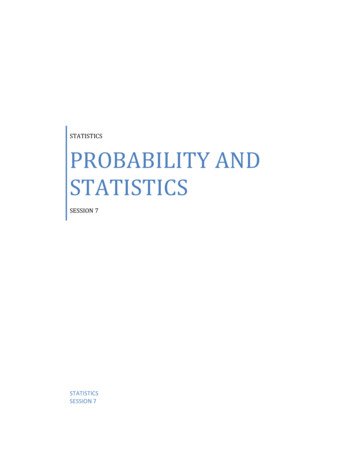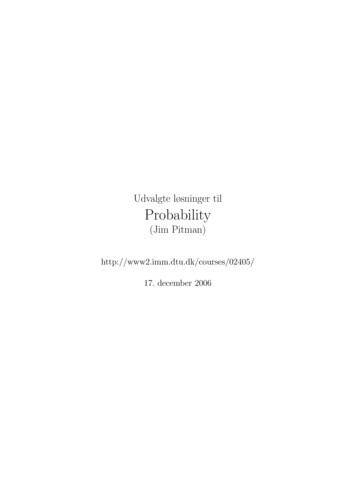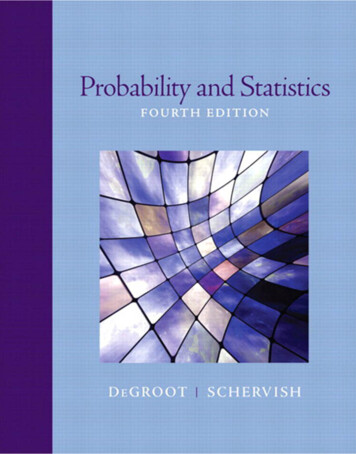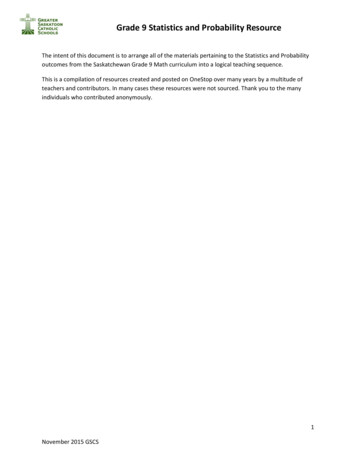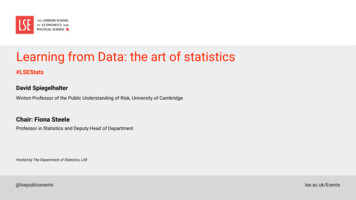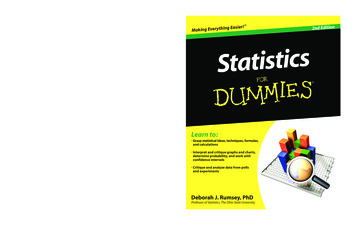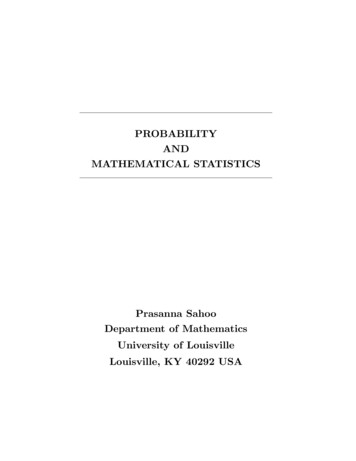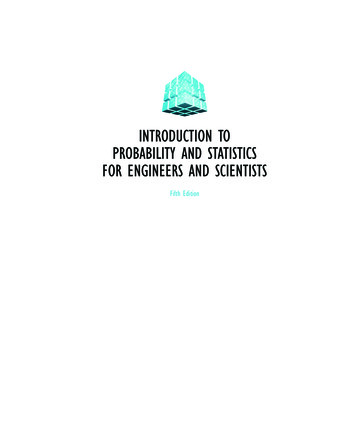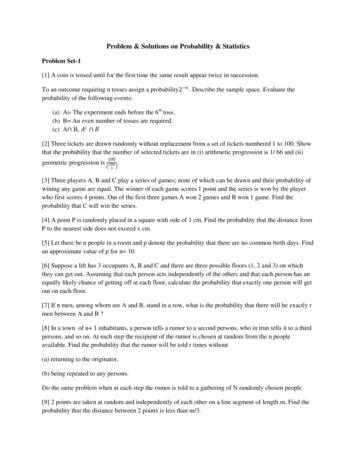
Transcription
Problem & Solutions on Probability & StatisticsProblem Set-1[1] A coin is tossed until for the first time the same result appear twice in succession.To an outcome requiring n tosses assign a probability2 𝑛 . Describe the sample space. Evaluate theprobability of the following events:(a) A The experiment ends before the 6th toss.(b) B An even number of tosses are required.(c) A B, 𝐴𝑐 𝐵[2] Three tickets are drawn randomly without replacement from a set of tickets numbered 1 to 100. Showthat the probability that the number of selected tickets are in (i) arithmetic progression is 1/ 66 and (ii)geometric progression is1051003.[3] Three players A, B and C play a series of games; none of which can be drawn and their probability ofwining any game are equal. The winner of each game scores 1 point and the series is won by the playerwho first scores 4 points. Out of the first three games A won 2 games and B won 1 game. Find theprobability that C will win the series.[4] A point P is randomly placed in a square with side of 1 cm. Find the probability that the distance fromP to the nearest side does not exceed x cm.[5] Let there be n people in a room and p denote the probability that there are no common birth days. Findan approximate value of p for n 10.[6] Suppose a lift has 3 occupants A, B and C and there are three possible floors (1, 2 and 3) on whichthey can get out. Assuming that each person acts independently of the others and that each person has anequally likely chance of getting off at each floor, calculate the probability that exactly one person will getout on each floor.[7] If n men, among whom are A and B, stand in a row, what is the probability that there will be exactly rmen between A and B ?[8] In a town of n 1 inhabitants, a person tells a rumor to a second persons, who in trun tells it to a thirdpersons, and so on. At each step the recipient of the rumor is chosen at random from the n peopleavailable. Find the probability that the rumor will be told r times without(a) returning to the originator,(b) being repeated to any persons.Do the same problem when at each step the rumor is told to a gathering of N randomly chosen people.[9] 2 points are taken at random and independently of each other on a line segment of length m. Find theprobability that the distance between 2 points is less than m/3.
[10] n points are taken at random and independently of one another inside a sphere of radius R. What isthe probability that the distance from the centre of the sphere to the nearest point is not less than r ?[11] A car is parked among N cars in a row, not at either end. On his return, the owner finds that exactly rof the N places are still occupied. What is the probability that both neighboring places are empty?[12] 3 points X, Y, Z are taken at random and independently of each other on a line segment AB. What isthe probability that Y will be between X and Z?[13] The coefficients of the equation 𝑎𝑥 2 𝑏𝑥 𝑐 0 are determined by throwing an ordinary die. Findthe probability that the framed equation will have real roots.[14] Let 𝛺 {1, 2, 3, 4}. Check whether any of the following is a 𝜍-field of subsets of 𝛺ℱ1 𝜙, 1, 2 , 3, 4ℱ2 {𝜙, 𝛺, 1 , 2, 3, 4 , {3, 4}}ℱ3 {𝜙, 𝛺, 1 , 2 , 1, 2 , 3, 4 , 2, 3, 4 , {1, 3, 4} }[15] Prove that if 𝐹1 𝑎𝑛𝑑 𝐹2 are 𝜍-fields of subsets of 𝛺, then 𝐹1 𝐹2 is also a 𝜍-field. Give a counterexample to show that similar result for union 𝜍- fields does not hold.[16] Let F be a 𝜍- field of subsets of the sample space 𝛺 and let 𝐴 𝐹 be a fixed. Show that 𝐹𝐴 {𝐶: 𝐶 𝐴 𝐵, 𝐵 𝐹} is a 𝜍-field of subsets of A.Solution Set-11) 𝛺 {HH, TT, HTT, THH, HTHH, THTT, .}𝑃 𝐻𝐻 1 𝑃 𝑇𝑇4𝑃 𝐻𝑇𝑇 𝑃 𝑇𝐻𝐻 a) 𝑃 𝐴 5𝑖 2 𝑃1.23exp 𝑒𝑛𝑑𝑠 𝑖𝑛 𝑖 𝑡𝑜𝑠𝑠𝑒𝑠 𝑃 exp 𝑒𝑛𝑑𝑠 𝑖𝑛 2 𝑡𝑜𝑠𝑠𝑒𝑠 𝑃 𝑒𝑛𝑑𝑠 𝑖𝑛 3 𝑃 𝑒𝑛𝑑𝑠 𝑖𝑛 4 𝑃 5 2 b) P(B) 21 𝑖 1 22𝑖11 2 3 222 c) P (A B) P(exp ends in 2 tosses) P(exp ends in 4 tosses) .𝑃 𝐴𝑐 𝐵 21 𝑖 3 22𝑖 .
2) Total # of cases : 1003(i)No. in APCommon diff 1, 2, . , 49# of cases 98, 96, , 2 Total # of favorable cases 98 96 249 502 2 49 50Reqd prob 49 5010031 661) No in GP.Common ratio can be integer or fractionCase 1: C. V. integerc. r.# f tav casestotal #2 (1, 2, 4), . (25, 50, 100) 253 (1, 3, 9), .(11, 33, 99) 4 (1, 4, 6), .(6, 24, 96) 6 45 (1, 5, 25), .6 (1, 6, 36),(4, 20, 100)(2, 12, 72)7 (1, 7, 49),11 2 (2, 14, 98)8 (1, 8, 64),2 19 (1, 9, 81) 110 (1, 10, 100) 1Total 53Case 2: c. r. fractional1st #c. r.tav cases321total # 4, 6, 9 , 8, 12, 18 , . 44, 66, 99 1152 4, 10, 25 , 8, 20, 50 , (12, 30, 75)(16, 40, 100) 472 4, 14, 49 , 8, 28, 98 2
92 (4, 18, 81) 1F9 4 5 7 8 10, , , ,3 3 3 3 36 5 7 9, ,4 4 45 6 7 8 9, , ,5 5 5 56 7619 4 6 4 2 1 1 4 2 1 2 2 1 1 28 9 10, ,7 7 798:1 1 1 1 1109 1Total 52 reqd prob.53 521003.3)C can win in exactly 4 or 5 or 6 or 7 additional gamesCase 1: 4 additional gamesC wins all prob1 43. (i)Case 2: 5 additional games.C wins 3 out of 1st 4 & the 5th game prob 1 3 233431 3 (ii)Case 3: 6 additional gamesC wins 3 out of 1st 5 & 6th game and either (i) B wins 2 and A wins on one or (ii) B wins 1, A wins 153Prob 1 3 1 2331 3 Case 4 : 7 additional games𝐴 𝑤𝑖𝑛𝑠 1Out of 1 6 games 𝐵 . .2𝐶 .3st53211 31 1.33 31 3 (iii)
𝑝𝑟𝑜𝑏631 31 1 233 33113(iv)Reqd. prob (i) (ii) (iii) (iv) m. e. ways.(4) The pt P must lie in the shaded region so that the distance from P to the nearest side does not exceed xcm.1If 𝑥 2 , 𝑡 𝑒𝑛 𝑝𝑟𝑜𝑏 11𝐼𝑓 0 𝑥 2 , 𝑡 𝑒𝑛 𝑎𝑟𝑒𝑎 𝑜𝑓 𝑡 𝑒 𝑠 𝑎𝑑𝑒𝑑 𝑟𝑒𝑔𝑖𝑜𝑛 1 (1 2𝑥)2 reqd. prob. 1-(1 2𝑥)2 .5) Reqd prob. 365 364 (365 (𝑛 1))365 𝑛𝑛 1log 𝑒 𝑝 log 𝑒𝑘 11 10 92For n 10 log 𝑒 𝑝 3651 1 365𝑘1 36521 365 1 𝑛 1 𝑘 1𝑛 1365 𝑝 𝑠𝑎𝑦𝑘1 𝑛(𝑛 1) .3653652 𝑝 6) Total # of possible outcomes: 33Tavarable # of outcomes : 3! 6Reqd. prob. 6.277) Total # of ways in which n men can stand in a row n!# of possible positions for A & B there are exactly r positions available between them 2! (n – r - 1) permutationpossible positionsamong A&B({1, r 2}, {2, r 3}, ., {(n- r-1), n} for A&B) Further # of ways that r persons can be chosen to stand between A& B Favarable # of cases2! 𝑛 𝑟 1 𝑛 2𝑟 𝑟! 𝑛 𝑟 2 ! 𝑛 2𝑟
Perm of rperm of (n- r- 2) men excluding A B and r men inMen betn A & Bbetween reqd. prob.2! 𝑛 𝑟 1 ! 𝑟! 𝑛!𝑛 2𝑟8)(a) Total # of of ways 𝑛𝑟𝑜𝑟𝑖𝑔𝑖𝑛𝑎𝑡𝑜𝑟 𝑛 𝑤𝑎𝑦𝑠2𝑛𝑑 𝑝𝑒𝑟𝑠𝑜𝑛 𝑛 1 𝑤𝑎𝑦𝑠 } 𝑛(𝑛 1)𝑟 1 𝑡 𝑟 𝑝𝑒𝑟𝑠𝑜𝑛 𝑛 1 𝑤𝑎𝑦𝑠Reqd. prob. 𝑛 𝑛 1 𝑟 1𝑛𝑟(b) Originator n options2nd person n- 13rd person n- 2 𝑟 𝑡 𝑝𝑒𝑟𝑠𝑜𝑛 (n- r 1)Reqd. prob. 𝑛 𝑛 1 (𝑛 𝑟 1)𝑛𝑟Second part:- Total # of casesCase tavarable to 1st event𝑛𝑁𝑛 𝑟.𝑁𝑛 1 𝑟 1𝑁𝑅𝑒𝑞𝑑 𝑝𝑟𝑜𝑏 𝑛𝑁𝑛 1 𝑟 1𝑁𝑛 𝑟𝑁Apply for 2nd event𝑅𝑒𝑞𝑑 𝑝𝑟𝑜𝑏 𝑛𝑁𝑛 𝑁 𝑛 2𝑁𝑁𝑁𝑛 𝑟𝑁 𝑛 (𝑟 1)𝑁𝑁 𝑤𝑖𝑡 𝑜𝑏𝑣𝑖𝑜𝑛𝑠 𝑎𝑠𝑠𝑢𝑚𝑝𝑡𝑖𝑜𝑛9) Let the distance of 2 randomly chosen pts from a fixed pt A on the line segment be denoted as x& y𝑚Reqd. condition is x- y 3 .
𝑖. 𝑒. 𝑚𝑚 𝑥 𝑦 33Note that x, y [0, m]Inside the rect bounded by x axis, y axis, x m and y m, the area favorable to x- y 𝑚3is clearly theregion OABCDEArea of OABCDE 𝑚2 2 2 2𝑚3 𝑚2 2 𝑟𝑒𝑞𝑑 𝑝𝑟𝑜𝑏 49𝑚2𝑚 2 𝑚 21 2𝑚 2𝑚 2 335 9.10) n pt must lie on or outside a sphere of raidus r, having same centre as the original sphere of raidus R.For any of the n pts,𝑣𝑜𝑙𝑚 𝑜𝑓 𝑠𝑝 𝑤𝑖𝑡 𝑟𝑎 𝑟𝑜𝑓 𝑠𝑝 𝑤𝑖𝑡 𝑟𝑎 𝑅P(lie inside the smaller sphere) 𝑣𝑜𝑙𝑚 P(lie on or outside the smaller sphere) 1 𝑟3 𝑅3 .𝑟3𝑅3As the pts are taken independently, the reqd. prob. 1 𝑟3𝑅3𝑛.11) Owner’s car can be in any of the (N- 2) places (leaving 2 ends)Remaining (r- 1) cars in (N- 1) remaining place Total # of cases (N- 2)𝑁 1𝑟 1Favorable # of cases:Owner’s car in any of the (N- 2) places and 2 neighboring places are empty remaining (r-1) cars can be in (N- 3) remaining places. favorable # of cases: (N- 2)Reqd. prob. 𝑁 3𝑟 1𝑁 1𝑟 1.𝑁 3𝑟 1.
12) Let x, y, 3 be the distances of X, Y, Z from a fixed pt P on the line segment the six possibilities arex y 3 ; x 3 y ; 3 x y;y x 3 ; y 3 x ; 3 y x;The above 6 possibilities are equally likely due to random drawsY lie between X & Z in 2 cases (x y 3 & 3 y x)2Reqd. prob. 613) Coefficient a, b or c can take any of the values 1, 2, Total # of (a, b, c) combinations 6 6 6 216Real roots requirement 𝑏 2 4𝑎𝑐Listing of favorable # of casesac1(a,c)(1 , 1)𝑏⃝ 𝑏 2 4𝑎𝑐2, 3, 4, 5, 64ac4# of cases52(1, 2) (2, 1)3(1 , 3) (3,1)4(1,4,(2,4)1 2)164, 5, 65(1,(5,5) 1)205, 62 2 46(1, 6)(6, 1) (2,3)(3, 2)245;64 2 883, 4, 5, 6124, 5, 62 4 82 3 63 3 9not possible to obtain ac 7(2, 4) (4, 2)3262 1 2ac values higher than 9 will not have any b 𝑏 2 4𝑎𝑐 # of favorable case for 𝑏 2 4𝑎𝑐 5 8 6 9 4 8 2 1 43
𝑟𝑒𝑞𝑑 𝑝𝑟𝑜𝑏 43.21614) (i) 𝜙 𝑐 𝛺 ℱ1 ℱ1 𝑖𝑠 𝑛𝑜𝑡 𝑎 𝜍 𝑓𝑖𝑒𝑙𝑑(ii) {1} {3, 4} {1, 3, 4} ℱ2ℱ2 is not closed under union ℱ2 is not a 𝜍-fieldOr {1, 2} {2, 3, 4} {2} ℱ2 ℱ2 is not 𝜍- field.(𝑖𝑖𝑖)ℱ3 contain 𝛺 and is closed under complementation and union ℱ3 is a 𝜍-field.15) 𝛺 ℱ1 , ℱ2 𝛺 ℱ1 ℱ2 (i)Let A ℱ1 ℱ2 , 𝑡 𝑒𝑛 𝐴 ℱ1 & 𝐴 ℱ2 𝐴𝑐 ℱ1 & 𝐴𝑐 ℱ2 𝐴𝑐 ℱ1 ℱ2 (ii)If 𝐴1 , 𝐴2 , ℱ1 ℱ2 , 𝑡 𝑒𝑛𝐴1 , 𝐴2 , ℱ1 & 𝐴𝑖 ℱ1𝐴1 , 𝐴2 , ℱ2 & 𝐴𝑖 ℱ2 𝐴𝑖 ℱ1 ℱ2 (iii)(i), (ii) & (iii) ℱ1 ℱ2 is a 𝜍-field.Counter example𝛺 {1, 2, 3}i.e. ℱ1 𝜙, 𝛺, 1 , 2, 3ℱ2 𝜙, 𝛺, 2 , 1, 3 𝜍 𝑓𝑖𝑒𝑙𝑑 𝜍 𝑓𝑖𝑒𝑙𝑑ℱ1 ℱ2 {𝜙, 𝛺, 1 , 2 , 1, 3 , {2, 3}}ℱ1 ℱ2 is not a 𝜍-field ({1} {2} ℱ1 ℱ2 )16)(i) A ℱ & A A A A ℱ𝐴 .(ii) Let C ℱ𝐴 𝑡 𝑒𝑛 𝐶 𝐴 𝐵 𝑓𝑜𝑟 𝐵 ℱ𝐶 𝐶𝐴 𝑐𝑜𝑚𝑝𝑙𝑒𝑚𝑒𝑛𝑡 𝑤. 𝑟. 𝑡. 𝐴 𝐴 𝐶
𝐴 𝐴 𝐵 𝐴 𝐵𝐶 ℱ𝐴 (𝑎𝑠 𝐵𝐶 ℱ𝐴 )(iii)Let 𝐶1 , 𝐶2 , ℱ𝐴 , 𝑡 𝑒𝑛𝐶𝑖 𝐴 𝐵𝑖 , 𝑖 1, 2, . 𝑓𝑜𝑟 𝐵𝑖 ℱ 𝐶𝑖 𝑈𝑈𝐴 𝐵𝑖 𝐴 𝐵 ℱ𝐴 𝑎𝑠 𝑈𝐵𝑖 ℱ𝑖𝑖 𝑖 ℱ𝐴 𝑖𝑠 𝑎 𝜍 𝑓𝑖𝑒𝑙𝑑 𝑜𝑓 𝑠𝑢𝑏𝑠𝑒𝑡𝑠 𝑜𝑓 𝐴.Problem Set -2[1] Let 𝛺 {0, 1, 2, }. If for an event A,(a) P(A) 𝑥 𝐴𝑒 𝜆 𝜆 𝑥𝑥!, 𝜆 0.𝑥 𝐴 𝑝(1 (b) P(A) 𝑝)𝑥 , 0 𝑝 1.1 𝑖𝑓 𝑡 𝑒 𝑛𝑢𝑚𝑏𝑒𝑟 𝑜𝑓 𝑒𝑙𝑒𝑚𝑒𝑛𝑡𝑠 𝑖𝑛 𝐴 𝑖𝑠 𝑓𝑖𝑛𝑖𝑡𝑒0 𝑜𝑡 𝑒𝑟𝑤𝑖𝑠𝑒.(c) P(A) Determine in each of the above cases whether P is a probability measure.In case where your answer is in the affirmative, determine P(E), P(F), P(G), P(E F), P(E F), P(F G),P(E G) and P(F G) , where E {x 𝛺 : x 2},F {x 𝛺 : 0 x 3} and G {x 𝛺: 3 x 6}.[2] Let 𝛺 ℜ. In each of the following cases determine whether P(.) is a probability measure. For aninterval I,(a) P(I) 𝐼1 𝑥 𝑒 𝑑𝑥20, 𝑖𝑓 𝐼 , 0 ,(b) P(I) (c) P(I) 2 𝐼 2𝑥𝑒 𝑥 𝑑𝑥 , 𝑖𝑓 𝐼 0, .1 𝑖𝑓 𝑙𝑒𝑛𝑔𝑡 𝑜𝑓 𝐼 𝑖𝑠 𝑓𝑖𝑛𝑖𝑡𝑒0 𝑜𝑡 𝑒𝑟𝑤𝑖𝑠𝑒[3] Show that the probability of exactly one of the events A or B occurring is P(A) P(A)- 2P(A B).[4] Prove thatP(A B)- P(A) P(B) P(A)P(𝐵𝑐 )- P(A 𝐵𝑐 )
𝑃 𝐴𝑐 𝑃 𝐵 𝑃 𝐴𝑐 𝐵 𝑃 𝐴 𝐵𝑐[5] For events 𝐴1 , 𝐴2 , . . , 𝐴𝑛 𝑠 𝑜𝑤 𝑡 𝑎𝑡 𝑃 1 𝑛 1 𝑃( 𝑛𝑖 1 𝐴𝑖 )𝑛𝑖 1 𝐴𝑖 𝑃(𝐴𝑐 )𝑃(𝐵𝑐 ) 𝑛𝑖 1 𝑃𝐴𝑖 1 𝑖1 𝑖2 𝑛𝑃(𝐴𝑖1 𝐴𝑖2 𝐴𝑖3 ) [6] Consider the sample space 𝛺 {, 1, 2, .}and ℱ the 𝜍-field of subsets of 𝛺. To the elementary event{j} assign the probability2𝑗P({j}) 𝐶 𝑗 ! , 𝑗 0, 1, 2, .(a) Determine the constant c.(b) Define the events A, B and C by A {j :2 j 4}, B {j : j 3} and C {j : j is an odd integer}.Evaluate P(A), P(B), P(C), P(A B), P(A C), P(C B), P(A B C) and verify the formula for P(A B C).[7] Each packet of a certain cereal contains a small plastic model of one of the five different dinosaurs; agiven packet is equally likely to contain any one of the five dinosaurs. Find the probability that someonebuying six packets of the cereal will acquire models of three favorite dinosaurs.[8] Suppose n cards numbered 1, 2, , n are laid out at random in a row. Let 𝐴𝑖 denote the event that‘card I appears in the ith position of the row’, which is termed as a match. What is the probability ofobtaining at least one match?[9] A man addresses n envelopes and writes n cheques for payment of n bills.(a) If the n bills are placed at random in the n envelopes, what would be the probability that eaxch billwould be placed in the wrong envelope?(b) If the bills and n cheques are placed at random in the n envelopes, one bill and one cheque in eachenvelope, what would be the probability that in no instance would the enclosures be completely correct?[10] For events A, B and C such that P(C) 0, prove that(a) P(A B c) P(A C) P(B C)- P(AB C)(b) P(𝐴𝐶 𝐶) 1- P(A C).[11] Let A and B be two events such that 0 P(A) 1. Which of the following statements are true?(a) P(A B) P(𝐴𝐶 𝐵) 1; (b) P(A B) P(A 𝐵𝐶 ) 1; (c) P(A B) P(𝐴𝐶 𝐵𝐶 ) 111[12] Consider the two events A and B such that P(A) 4, P(B A) ½ and P(A B) 4.Which of the following statements are true?(a) A and B are mutually exclusive events,
(b) A B,3(c) P(𝐴𝐶 𝐵𝐶 4,(d) P(A B) P(A 𝐵𝐶 ) 1[13] Consider an urn in which 4 balls have been placed by the following scheme. A fair coin is tossed, ifthe coin comes up heads, a white ball is placed in the urn otherwise a red ball is placed in the urn.(a) What is the probability that the urn will contain exactly 3 white balls?(b) What is the probability that the urn will contain exactly 3 white balls, given that the first ball placed inthe urn was white?[14] A random experiment has three possible outcomes, A, B and C, with probabilities𝑝𝐴 , 𝑝𝐵 , 𝑎𝑛𝑑 𝑝𝐶 .What is the probability that, in independent performances of the experiment, A will occur before B?[15] a system composed of n separate components is said to be a parallel system if it functions when atleast one of the components functions. For such a system, if component I, independent of othercomponents, functions with probability𝑝𝑖 , 𝑖 1(1)𝑛, what is the probability that the system functions?[16] A student has to sit for an examination consisting of 3 questions selected randomly from a list of 100questions. To pass, the student needs to answer correctly all the three questions. What is the probabilitythat the student will pass the examination if he remembers correctly answer to 90 questions o the list?[17] A person has three coins in his pocket, two fair coins (heads and tails are equally likely) but the thirdone is baised with probability of heads 2/3. One coin selected at random drops on the floor, landing headsup. How likely is it that it is one of the fair coins?[18] A slip of paper is given to A, who marks it with either a or a- sign, with a probability 1/3 of writinga sign. A passes the slip to B, who may either leave it unchanged or change the sign before passing it toC. C in turn passes the slip to D after perhaps changing the sign; finally D passes it to a referee afterperhaps changing the sign. It is further known that B, C and D each change the sign with probability 2/3.Find the probability that A originally wrote a given that the referee sees a sign o the slip.[19] Each of the three boxes A, B, and C, identical in appearance, has two drawers. Box A contains a goldcoin in each drawer, Box B contains a silver coin in each drawer and box C contains a gold coi in onedrawer and silver coin in the other. A box is chosen at random and one of its drawers is then chosen atrandom and opened, and a gold coin is found. What is the probability that the other drawer of this boxcontains a silver coin?[20] Each of four persons fires one shot at a target. Let 𝐶𝑘 denote the event that the target is hit by personk, k 1, 2, 3, 4. If the events 𝐶1 , 𝐶2 , 𝐶3 , 𝐶4 are independent and if P(𝐶1 ) P(𝐶2 ) 0.7,P(𝐶3 ) 0.9 and P(𝐶4 ) 0.4, compute the probability that : (a) all of them hit the target; (b) no one hits thetarget; (c) exactly one hits the target; (d) at least one hits the target.[21] Let 𝐴1 , 𝐴2 , . . , 𝐴𝑛 be n independent events. Show that 𝑃𝐶𝑛𝑖 1 𝐴𝑖 exp 𝑛𝑖 1 𝑃𝐴𝑖 .
[22] Give a counter example to show that pair wise independence of a set of events 𝐴1 , 𝐴2 , . . , 𝐴𝑛 doesnot imply mutual independence.[23] We say that B carries negative information about event A if P(A B) P(A). Let A, B and C be threeevents such that B carries negative information about A and C carries negative information about B. Is ittrue C carries negative information about A ? Prove your assertion.[24] Suppose in a class there are 5 boys and 3 girl students. A list of 4 students, to be interviewed, is madeby choosing 4 students at random from this class. If the first student selected at random from the list, forinterview, is a girl, then find the conditional probability of selecting a boy next from among the remaining3 students in the list.[25] During the course of an experiment with a particular brand of a disinfectant on files, it is found that80% are killed in the first application. Those which survive develop a resistance, so that the percentage ofsurvivors killed in any later application is half of that in the preceding application. Find the probabilitythat (a) a fly will survive 4 applications; (b) it will survive 4 applications, given that it has survived the 1 stone.[26] An art dealer receives a group of 5 old paintings and on the basis of past experience, the thinks thatthe probabilities are, 0.76, 0.09, 0.02, 0.01, 0.02 and 0.10 that 0, 1, 2, 3, 4 or all 5 of them, respectively,are forgeries. The art dealer sends one randomly chosen (out of 5) paintings for authentication. If thispainting turns out to be a forgery, then what probability should he now assign to the possibility that theother 4 are also forgeries?Solution Key(1) (a) 𝛺 {0, 1, 2, .}P(A) 𝑥 𝐴𝑒 𝜆 𝜆 𝑥𝑥!, 𝜆 0.𝑒 𝜆 𝜆 𝑥𝑥!P(A) 0 obv (i)P(𝛺) Define 𝐴𝑖 𝑥 𝛺: 𝑖 1 𝑥 𝑖 1 𝑖In general, 𝐴1 , 𝐴2 , .𝑃 1 𝐴𝑖 1 𝑃𝑃𝑥 𝛺 𝑃 1, 2, 1 𝑃 𝑋 0 𝑒 𝜆𝑥 𝜆0 𝑥! 1 (i) 𝐴𝑖 𝐴𝑗 𝜙 𝑖 𝑖 𝑗𝐴𝑖 𝑃 𝐴1 1 𝑃 𝑋 0 1 𝐴𝑖 1 𝑃𝑃𝐴𝑖 (iii) P is prob. Measure.(b)Similar to (a).(c) P(A) 0P(𝛺) 0 ( 𝛺 is infinite).𝐴𝑖 𝑖 𝑃 𝑥𝑥 𝑈𝐴𝑖𝑃({𝑥}) 𝑖𝑥 𝐴𝑖𝑃(𝐴𝑖 )𝑖
P is not prob. Measure.Note:- Also take, 𝐴𝑖 {𝑖} i 1, 2, Then 𝑈𝐴𝑖 {1, 2, } -infinite # of elements 𝑃 𝐶𝑖 0 𝑃 𝐶𝑖 11112nd part 𝜆 𝑥 𝑒 𝜆3𝑥!(a) P(E) 1 𝑒 𝜆 1 𝜆 𝜆22!2𝑃 𝐹 1 𝑃 𝐸 𝐹 1𝑒 𝜆 𝜆𝑥𝜆2 𝑒 𝜆 𝜆 𝑥!2!𝑒 𝜆 𝜆𝑥𝑒 𝜆 𝜆0 1 1 𝑒 𝜆𝑥!0!𝑜𝑡 𝑒𝑟𝑠.( 2) 𝛺 R𝑎 𝑃 𝐼 𝐼1 𝑥 𝑒 𝑑𝑥2 0 𝐼10 P(𝛺) ½ 𝑒 𝑥 𝑑𝑥 2 𝑒 𝑥 𝑑𝑥 0 𝑒 𝑥 𝑑𝑥 1𝐼1 𝐼2 𝜙 𝑃 𝐼1 𝐼2 12 𝐼 𝐼12 𝑃 𝐼1 𝑃 𝐼2 𝑒𝑥𝑡𝑒𝑛𝑑𝑒𝑑 . P is prob measure𝑏 𝑆𝑖𝑚𝑖𝑙𝑎𝑟 𝑡𝑜 (𝑎)𝑐 P(𝛺) P(ℜ) 0 1 P is not prob measure.(3) P(exactly me of A or B) 𝑃( 𝐴 𝐵𝑐 𝐴𝑐 𝐵 𝑃 𝐴 𝑃 𝐵 2𝑃(𝐴 𝐵) on simplification.𝑃 𝐴𝐵 𝑃 𝐴 𝑃 𝐵 𝑃 𝐴 𝑃 𝐵𝑐 𝑃(𝐴𝐵𝑐 ). 1st equation.[𝑈𝑠𝑖𝑛𝑔 𝑃 𝐴 𝑃 𝐴𝐵 𝑃 𝐴𝐵𝑐 . ]2nd & 3rd equation is can be proved in a similar way.(5) For n 2
𝑃 𝐴1 𝐴2 𝑃 𝐴1 𝐴1 𝑐 𝐴2 𝑃 𝐴1 𝑃 𝐴1 𝑐 𝐴2 𝑃 𝐴1 [𝑃 𝐴2 𝑃 𝐴1 𝐴2 ] true for n 2𝑃𝑟𝑜𝑜𝑓 by indention𝐴𝑟𝑢𝑚 that it is true for n m, then𝑚 1𝑃𝑚𝐴𝑘 𝑃𝐴𝑘 𝐴𝑚 111𝑚 𝑃𝑚𝐴𝑘 𝑃 𝐴𝑚 1 𝑃𝐴𝑘 𝐴𝑚 111𝑚𝑛𝑟. . 𝑠 𝑃 𝐴𝑘 1𝑃 𝐴𝑘 1 𝐴𝑘 2 𝑘 1 𝑘 2𝑃 𝐴𝑘 1 𝐴𝑘 2 𝐴𝑘 3 1𝑚 1𝑃𝑘 1 𝑘 2 𝑘 31𝑚 𝑃 𝐴𝑚 1 𝑃𝐴𝑘 𝐴𝑚 11(1)𝑚𝑃𝐴𝑘 𝐴𝑚 11𝑛 𝑃 𝐴𝑘 𝐴𝑚 1 1𝑃 𝐴𝑘 1 𝐴𝑚 1 𝐴𝑘 2 𝐴𝑚 1𝑘 1 𝑘 2 𝑃 𝐴𝑘 1 𝐴𝑚 1 𝐴𝑘 2 𝐴𝑚 1 𝐴𝑘 3 𝐴𝑚 1 𝑘 1 𝑘 2 𝑘 3 1𝑚𝑚 1𝑃𝐴𝑘 𝐴𝑚 1 (2)1𝑈𝑠𝑖𝑛𝑔 2 𝑖𝑛 (1) gives𝑚 1𝑃𝐴𝑘1𝑚 1 𝑚 1𝑃 𝐴𝑘 1 1𝑃 𝐴𝑘 1 𝐴𝑘 2 𝑘 1 𝑘 2𝑚𝑚 1𝑃𝐴𝑘 .1𝐴𝑘𝑃 𝐴𝑘 1 𝐴𝑘 2 𝐴𝑘 3 𝑘 1 𝑘 2 𝑘 3
2𝑗6) 𝛺 {0, 1, 2, .}. P({j}) 𝑐 𝑗 ! 𝐶𝑒 2 𝐶 𝑒 24𝑏 𝑃 𝐴 𝑒 222𝑗;𝑃 𝐵 𝑗! 𝑒3𝑃 𝐵 𝐶 𝑃 3 22𝑗;𝑃 𝐶 𝑗! 𝑃 5 𝑒 2022𝑗 12𝑗 1 ! Other probs can be completed in a similar manner(7) Favorite models of dinosaurs numbered 1, 2, 3 (say) define events𝐴𝑖 model # I not found in 6 pockets.𝑖 1, 2, 3Reqd. prob. 𝑃 𝐴1 𝑐 𝐴2 𝑐 𝐴3 𝑐 1 𝑃 𝐴1 𝑐 𝐴2 𝑐 𝐴3 𝑐𝑐 1 𝑃 𝐴1 𝐴2 𝐴3 1 𝑃 𝐴1 𝑃 𝐴2 𝑃 𝐴3 𝑃 𝐴1 𝐴2 𝑃 𝐴1 𝐴3 𝑃 𝐴1 𝐴3 𝑃 𝐴1 𝐴2 𝐴34 653 6𝑃 𝐴𝑖 𝑁ote that 𝑃 𝐴𝑖 𝐴𝑗 5𝑃 𝐴1 𝐴2 𝐴3 (1) 𝑖 𝑖 𝑗 (2)2 65Use (2) in (1) get the desired prob.(8) 𝐴𝑖 : match at position iP(at least one match) P(𝐴1 𝐴2 𝐴𝑛 ) 𝑛1𝑃(𝐴𝑖 ) 𝑃(𝐴𝑖1 𝐴𝑖2 𝐴𝑖𝑟 𝑖 𝑗𝑃(𝐴𝑖 𝐴𝑗 ) 11 1 12! 3!𝑛 1(9)(a) 𝐴𝑖 : event that ith bill goes to ith envelope (i 1(1) n) 1 1 𝑐𝑛𝑖 1 𝐴𝑖𝑃 𝐴𝑖 𝑃 𝐴𝑖 𝑄1𝑖 𝑗𝑖 𝑗 1 𝑃𝑃(𝑛1𝐴𝑖 )𝑛 𝑟 !; 1 𝑖1 𝑖2 𝑖𝑟 𝑛 𝑟 1(1)𝑛𝑛!𝑟𝑒𝑞𝑑 𝑝𝑟𝑜𝑏 1 𝑟𝑒𝑞𝑑. Prob. 𝑃𝑛 1𝐴𝑖𝑃 𝐴𝑖 𝐴𝑗 1𝑛 1𝑃 𝐴1 , , 𝐴𝑟𝑛 𝑃 𝐴𝑖 𝐴𝑗 𝑄2 ( 1) 𝑃 𝐴1 , , 𝐴𝑟 𝑄𝑛1𝑛!
𝑛𝑛 𝑖 !1𝑡𝑒𝑟𝑚𝑠 𝑒𝑎𝑐 𝑒𝑞𝑢𝑎𝑙 𝑡𝑜 𝑖𝑛!(𝑛)𝑖𝐼𝑛 𝑄𝑖 𝑛1𝐴𝑖 𝑐 1 𝑃 1 1𝑛 𝑛 121 1𝑛 2𝑛𝑛𝑛1𝑛 𝑛𝑛!𝑛 1 !𝑛!𝑛 2 !1. . 1 𝑛 .1! 𝑛 1 !𝑛!2! 𝑛 2 !𝑛!𝑛!1 1 1 11! 2!𝑛1𝑛 𝑛!( 1)𝑖𝑖 01𝑛!(b) 𝐵𝑖 : ith envelope get ith bill & ith cheque𝑟𝑒𝑞𝑑. Prob. 𝑃𝐵𝑖 𝑐 1 𝑃𝐵𝑖 1 In 𝑅𝑖 𝑛𝑖𝑡𝑒𝑟𝑚 𝑒𝑎𝑐 𝑒𝑞𝑢𝑎𝑙 𝑡𝑜 𝑃𝑐 1 𝑃𝑖 𝐵𝑖𝑖 𝐵𝑖𝑃 𝐵𝑖 𝑛 𝑖 ! 𝑛 𝑖 !. 𝑛!𝑛! 1 𝑖𝑃𝐵𝑖 𝑖 𝑗𝑃 𝐵𝑖 𝐵𝑗 1 𝑛 𝑃(𝐵1 𝐵𝑛 ) 𝑅1𝑅2.𝑖 𝑗𝑃 𝐵𝑖 𝐵𝑗 1 𝑛 𝑃 𝐵1 𝐵𝑛 1 𝑅1 𝑅2 𝑅3 1 𝑛 𝑅𝑛𝑅𝑖 𝑛𝑖𝑛 𝑖 !𝑛 𝑖 ! 𝑛!𝑛!𝑛!𝑛 𝑖 ! 𝑛 𝑖 ! 1 1. . 𝑛𝑖! 𝑛 𝑖 !𝑛!𝑛!𝑖! 𝑛 𝑖𝑛 𝑃𝐵𝑖𝑐 𝑖 0𝑖(10) (i) P(A B C) 𝑃 𝐴 𝐵 𝐶𝑃 𝐶 1𝑖1.𝑖! 𝑛 𝑖𝑃 𝐴𝐶 𝐵𝐶𝑃 𝐶 𝑃 𝐴 𝐶) 𝑃 𝐵 𝐶 𝑃 𝐴𝐵 𝐶)(ii)𝑃 𝐴𝑐 𝐶) 𝑃(𝐴𝑐 𝑐)𝑃(𝐶)(11) (a) true – 𝑃 𝐴 𝐵 𝑃 𝐴𝑐 𝐵 (b) 𝑃 𝐴 𝐵 𝑃 𝐴𝐵𝑃 𝐵; 𝑃 𝐴 𝐵𝑐 𝑃 𝐶 �� 𝐴𝐵 𝑐𝑃 𝐵𝑐 𝑃(𝐴𝑐 𝐵)𝑃(𝐵)𝑃 𝐴 𝑃 𝐴𝐵1 𝑃 𝐵 1 𝑃(𝐴 𝐶)𝑃(𝐵)𝐵 𝑃𝑖 1 𝑛!𝑛 𝑖 ! 𝑅𝑛
𝑇𝑎𝑘𝑒 𝐴 𝐵, 𝑃 𝐴 0, 𝑃 𝐵 𝐴 0𝑃 𝐴 𝐵 𝑃 𝐴 𝐵𝑐 𝑃(𝐴𝐵) 𝑃(𝐴𝐵𝑐 ) 𝑃 𝐴 1 𝑓𝑎𝑙𝑠𝑒.𝑃(𝐵)𝑃(𝐵𝑐 )𝑃(𝐵)(c) Take A B, i.e. 𝐵𝑐 𝐴𝑐𝑃 𝐴 𝐵 𝑃 𝐴𝑐 𝐵𝑐 . 𝑃(𝐴𝐵) 𝑃 𝐴𝑐 𝐵𝑐 1 𝑓𝑎𝑙𝑠𝑒.𝑃(𝐵)𝑃(𝐵𝑐 )1(12) (a) 𝑃 𝐴 𝐵 4 𝑃 𝐴𝐵 0 (i.e. AB 0)(b) 𝐴𝐶𝐵 𝑃 𝐴𝐵 𝑃 𝐴𝐺𝑖𝑣𝑒𝑛 𝑃 𝐵 𝐴 (c) 𝑃 𝐴𝑐 𝐵𝑐 𝑃 𝐴𝑐 𝐵 𝑐𝑃 𝐵𝑐𝑃(𝐴𝐵) 1 𝑃 𝐴𝐵 𝑃 𝐴 𝑓𝑎𝑙𝑠𝑒.𝑃(𝐴)21 𝑃 𝐴 𝑃 𝐵 𝑃 𝐴𝐵1 𝑃 𝐵 ( )𝑃 𝐵𝐴 141218& 𝑃 𝐴 , 𝑃 𝐴𝐵 1𝑃(𝐴𝐵)11&𝑃 𝐴 𝐵 8 𝑃 𝐵 𝑃(𝐵)𝑃(𝐵) 42𝑐(*) 𝑃 𝐴 𝐵𝑐 1 1 14 2 8121 3 4.(13) (a) P(exactly 3 white balls, out of 4) 431 3 1.22 (b)A : first ball placed is white𝑃 𝐴 121𝑃(𝐴𝐵) 2 .𝐵: 𝑢𝑟𝑛 𝑐𝑜𝑛𝑡𝑎𝑖𝑛 𝑒𝑥𝑎𝑐𝑡𝑙𝑦 3 𝑤 𝑖𝑡𝑒 𝑏𝑎𝑙𝑙𝑠 𝑃 𝐵 𝐴 𝑃(𝐴)12321233 .8
(14) D: A occurs before B𝑃 𝐷 𝑝𝐴 𝑝𝐴 𝑝𝐶 𝑝𝐴 𝑝𝐶 2 𝑝𝐴𝑝𝐴 1 𝑝𝐶 𝑝𝐴 𝑝𝐵𝐴𝑖 : 𝑐𝑜𝑚𝑝𝑜𝑛𝑒𝑛𝑡 𝑖 𝑓𝑢𝑛𝑐𝑡𝑖𝑜𝑛𝐴𝑖 𝑐 1 (1 𝑝)𝑛P(system function) 1 𝑃(16) 𝐴𝑖 : Question I is among the 90 questions that the student can answer correctly.Reqd. prob. 𝑃 𝐴1 𝐴2 𝐴3 𝑃 𝐴1 𝑃 𝐴2 𝐴1 𝑃 𝐴3 𝐴1 𝐴2 ) 90 89 88. . .100 99 98(17) Apply bayes theoremReqd. prob. 1 2 2 31 2 2 1 2 3 3 3 (18) 𝐴 , 𝐵 , 𝐶 , 𝐷 -events that A, B, C, D passes the paper with (t) signbayes theoremReqd. prob. P 𝐴 𝐷 𝑃 𝐴 𝑃 𝐷 𝐴 𝑃 𝐷 13𝑃 𝐷 𝐴 ) 3 322321 13. 3 27𝑎𝑙𝑠𝑜 𝑃 𝐷 𝑃 𝐷 𝐴 𝑃 𝐴 𝑃 𝐷 𝐴 𝑐 𝑃 𝐴 𝑐𝑃 𝐷 𝐴 𝑐 𝑃 𝐷 𝑝𝑎𝑠𝑠𝑒𝑠 𝑤𝑖𝑡 𝐴 𝑝𝑎𝑠𝑠𝑒𝑠 ). 3 2 11 3 32𝑃 𝐷 𝑃 𝐴 𝐷 13 1.27 3418113 41 .(19) silver coin in otherP(h Gold coin in one drawer).Bayes thm 33233130 13 1 14 2 41. . 27 3 27 3 811427
1 1 3 21 1 1 1 033 2 31 1 3.41 𝑃(𝐶𝑖 )(20) (a) 𝑃 𝐶1 𝐶2 𝐶3 𝐶4 (b) 𝑃 𝐶1 𝑐 𝐶2 𝑐 𝐶3 𝑐 𝐶4 𝑐 41 𝑃(𝐶𝑖 𝑐 ) [𝑒𝑥𝑝𝑙𝑎𝑖𝑛 𝑤 𝑦 𝑖𝑠 𝑠𝑜 𝐶1 , 𝐶2 , 𝐶3 , 𝐶4 𝑖𝑛𝑑𝑒𝑝𝑒𝑛 𝐶1 𝑐 , 𝐶2 𝑐 , 𝐶3 𝑐 , 𝐶4 𝑐 𝑎𝑟𝑒 𝑎𝑙𝑠𝑜 𝑖𝑛𝑑𝑒𝑝𝑒𝑛. ](c) 𝑃 𝐶1 𝐶2 𝑐 𝐶3 𝑐 𝐶4 𝑐 𝑃 𝐶1 𝑐 𝐶2 𝐶3 𝑐 𝐶4 𝑐 𝑃 𝐶1 𝑐 𝐶2 𝑐 𝐶3 𝐶4 𝑐 𝑃 𝐶1 𝑐 𝐶2 𝑐 𝐶3 𝑐 𝐶4 𝑐4𝑃 𝐶𝑖 3 𝑃 𝐶12(d) P(at least one hits) 1 𝑃 𝑛𝑜 𝑜𝑛𝑒 𝑖𝑡𝑠 1 𝑃 𝐶1 𝑐 𝐶2 𝑐 𝐶3 𝑐 𝐶4 𝑐 (21) 𝑃𝑖. 𝑒. 𝑃𝑛1𝑛1𝐴𝑖 𝑐 𝑛1𝑃 𝐴𝑖 𝑐 𝐴𝑖 𝑐 exp( 𝑛1𝑛11 𝑃 𝐴𝑖 𝑛1exp 𝑃 𝐴𝑖0 𝑥 1, 1 𝑥 𝑒 𝑥𝑃(𝐴𝑖 )).(22) 𝛺 {1, 2, 3, 4} 7: Proper set𝑃 𝑖 1𝑖 1, 2, 3, 44A {1, 4} , B {2, 4}, C {3, 4}.P(A) P(B) P(C) ½11𝑃 𝐴𝐵 𝑃 𝐴𝐶 𝑃 𝐵𝐶 ; 𝑃 𝐴𝐵𝐶 44 𝑃 𝐴𝐵 𝑃 𝐴 𝑃 𝐵 , 𝑃 𝐴𝐶 𝑃 𝐴 𝑃 𝐶 & 𝑃 𝐵𝐶 𝑃 𝐵 𝑃(𝐶)i.e. A, B, C are pair wise independent11but P(ABC) 4 𝑃 𝐴 . 𝑃 𝐵 . 𝑃 𝐶 8 𝐴, 𝐵, 𝐶 𝑛𝑜𝑡 𝑚𝑢𝑡𝑢𝑎𝑙𝑠 𝑖𝑛𝑑𝑒𝑝.(23) Counter exampleIn prv prob set up takeA {1, 2}, B {3, 4}, C {1}P(A B) P(A)P(B C) P(B) but P(A C) P(A)
C does not carry negative information about A.(24) 𝐴𝑖 : I gives are in the list i 0, 1, 2, 3B : 1st student is girl.C : 2nd student is boy:- to obtain P(C B)31P(B) 𝑃 𝐴1 𝑃 𝐵 𝐴1 𝑃 𝐴2 𝑃 𝐵 𝐴2 𝑃 𝐴3 𝑃 𝐵 𝐴3 𝑃 𝐵 1054 84𝑃 𝐶 31 𝐴𝑖 𝐵𝑃 𝐶𝐵𝑃 𝐶𝐵 𝑃 𝐵𝑃 𝐵84531 4 3284 𝑃31 𝐶𝐴𝑖 𝐵𝑃 𝐵𝑃 𝐶 𝐴𝑖 𝐵 𝑃 𝐴𝑖 𝐵121 1 𝑃 𝐴1 𝐵 𝑃 𝐴2 𝐵 𝑃 𝐴3 𝐵33𝑃 𝐴1 𝑃 𝐵 𝐴12 𝑃 𝐵7𝑃 𝐴2 𝑃 𝐵 𝐴141𝑃 𝐴2 𝐵 𝑃 𝐴3 𝐵) 𝑃 𝐵77𝑃 𝐴1 𝐵 2 2 4 1 1 𝑃 𝐶 𝐵 1 7 3 7 3 7(25)𝐴𝑖 : event that a fly survives ith application i 1, 2, 3, 4Note that 𝐴4 𝐴3 𝐴2 𝐴1 𝐴4 𝐴1 𝐴2 𝐴3 𝐴4(a) Reqd. prob. P(a fly survives 4 applications) P 𝐴1 𝐴2 𝐴3 𝐴4 𝑃 𝐴4 𝑃 𝐴1 𝑃 𝐴2 𝐴1 𝑃 𝐴3 𝐴1 𝐴2 𝑃(𝐴4 𝐴1 𝐴2 𝐴3 ) (1- 0.8) (1- 0.4) (1- 0.2) (1- 0.1)2 4 .3 523384513 4
(for the given conditions) 0.2 0.6 0.8 0.9(b) 𝑃 𝐴4 𝐴1 𝑃 𝐴4 𝐴1𝑃 𝐴1𝑃 𝐴4𝐴1 𝑃 0.6 0.8 0.9(26) 𝐵𝑖 : event that I of the paintings are forgeries i 0(1) 5P(𝐵0 ) 0.76, 𝑃 𝐵1 0.09, 𝑃 𝐵2 0.02, 𝑃 𝐵3 0.01, 𝑃 𝐵4 0.02 & 𝑃 𝐵5 0.1 (𝑔𝑖𝑣𝑒𝑛 𝑐𝑜𝑛𝑑𝑖𝑡𝑖𝑜𝑠)A : event that the painting sent for authentication turns out to be a forgery.𝑃 𝐵5 𝑃 𝐴 𝐵5 )𝐵𝑖 𝑃(𝐴 𝐵𝑖 )Reqd. prob. 𝑃 𝐵5 𝐴 5𝑖 0 𝑃 Bayes them5𝑃 𝐴 𝑃 𝐵𝑖 𝑃(𝐴 𝐵𝑖 )𝑖 01234 0.76 0 0.09 0.02 0.01 0.02 0.10 15555 𝑃 𝐵5 𝐴 0.10 1 𝑃(𝐴)Problem Set-3[1] Let X be a random variable defined on (𝛺, ℑ, 𝑃).Show that the following are also random variables;(a) X , (b) 𝑋 2 𝑎𝑛𝑑 𝑐 𝑋, given that {x 0} 𝜙.[2] Let 𝛺 [0, 1] and ℑ be the Boral 𝜍-field of subsets of 𝛺. Define X on 𝛺 as follows:𝜔 𝑖𝑓 0 𝜔 𝑋 𝜔 𝜔 1211𝑖𝑓 𝜔 122
Show that X defined above is a random variable.[3] Let 𝛺 {1, 2, 3, 4} and ℑ {𝜙, 𝛺, {1}, {2, 3, 4}} be a 𝜍-field of subsets of 𝛺. Verify whether𝑋 𝜔 𝜔 1; 𝜔 𝛺, is a random variable with respect to ℑ.[4] Let a card be selected from an ordinary pack of playing cards. The outcome 𝜔 is one of these 52 cards.Define X on 𝛺 as :4 𝑖𝑓 𝜔 𝑖𝑠 𝑎𝑛 𝑎𝑐𝑒3 𝑖𝑓 𝜔 𝑖𝑠 𝑎 𝑘𝑖𝑛𝑔𝑋 𝜔 2 𝑖𝑓 𝜔 𝑖𝑠 𝑎 𝑞𝑢𝑒𝑒𝑛1 𝑖𝑓 𝜔 𝑖𝑠 𝑎 𝑗𝑎𝑐𝑘0 𝑡 𝑒𝑟𝑤𝑖𝑠𝑒.Show that X is a random variable. Further, suppose that P(.) assigns a probability of 1/52 to each outcome𝜔. Derive the distribution function of X.0 𝑖𝑓 𝑥 1(𝑥 2)4[5] Let F(x) 𝑖𝑓 1 𝑥 11 𝑖𝑓 𝑥 1Show that F(.) is a distribution function. Sketch the graph of F(x) and compute the probabilities P(- ½ X12 ) , 𝑃 𝑋 0 , 𝑃 𝑋 1 𝑎𝑛𝑑𝑃( 1 𝑥 1). Further, obtain the decomposition F(x) 𝛼 𝐹𝑑 𝑥 1 𝛼 𝐹𝑐 (𝑥); where 𝐹𝑑 𝑥 𝑎𝑛𝑑𝐹𝑐 (𝑥) are purely discrete and purely continuous distribution functions,respectively.[6] Which of the following functions are distribution function?0, 𝑥 01(a) F(x) 𝑥, 0 𝑥 211, 𝑥 ; (b) 𝐹 𝑥 0 𝑥 10, 𝑥 0; (c)𝐹 𝑥 1 1 𝑥 1𝑥1 𝑒 , 𝑥 𝑥2[7]𝐿𝑒𝑡 𝐹 𝑥 0 𝑖𝑓 𝑥 01 2 𝑥/3𝑒31 3 𝑒 [𝑥/3] 𝑖𝑓 𝑥 0Where, [x] is the largest integer x. show that F(.) is a distribution function and compute P(X 6), P(X 5) and P(5 𝑋 8).[8] The distribution function of a random variable X is given by0, 𝑥 2,F(x) 1, 2 𝑥 0,31, 0 𝑥 5,21𝑥 5 2 , 5 𝑥 221, 𝑥 66
𝐹𝑖𝑛𝑑 𝑃 2 𝑋 5 , 𝑃 0 𝑋 5.5 𝑎𝑛𝑑 𝑃 1.5 𝑋 5.5 𝑋 2).[9] Prove that if 𝐹1 . , . , 𝐹𝑛 . 𝑎𝑟𝑒 𝑛 𝑑𝑖𝑠𝑡𝑟𝑖𝑏𝑢𝑡𝑖𝑜𝑛 𝑓𝑢𝑛𝑐𝑡𝑖𝑜𝑛𝑠, 𝑡 𝑒𝑛 𝐹 𝑥 distribution function for any (𝛼1 , , 𝛼𝑛 ), such that 𝛼𝑖 0and 𝑛𝑖 1 𝛼𝑖 1.𝑛𝑖 1 𝛼𝑖 𝐹𝑖 (𝑥)is also a[10] Suppose 𝐹1 𝑎𝑛𝑑 𝐹2 are distribution functions. Verify whether G(x) 𝐹1 𝑥 𝐹2 (𝑥)is also adistribution function.[11] Find the value of 𝛼 and k so that F given byF(x) 0 𝑖𝑓 𝑥 0 𝑘𝑒 𝑥2 /2𝑖𝑓 𝑥 0Is distribution function of a continuous random variable.0 𝑖𝑓 𝑥 0(𝑥 2)8𝑥 2 2[12] Let F(x) 82𝑥 𝑐8𝑖𝑓 0 𝑥 1𝑖𝑓 1 𝑥 2𝑖𝑓 2 𝑥 31 𝑖𝑓 𝑥 3Find the value of c such that F is a distribution function. Using the obtained value of c, find thedecomposition F(x) 𝛼 𝐹𝑑 𝑥 1 𝛼 𝐹𝑐 (𝑥); where 𝐹𝑑 𝑥 𝑎𝑛𝑑𝐹𝑐 (𝑥) are purely discrete and purelycontinuous distribution functions, respectively.[13] Suppose 𝐹𝑋 is the distribution function of a random variable X. Determine the distribution functionof a 𝑋 𝑎𝑛𝑑 𝑏 𝑋 . Where𝑋 𝑋 𝑖𝑓 𝑋 00 𝑖𝑓 𝑋 0[14]The convolution F of two distribution functions 𝐹1 𝑎𝑛𝑑 𝐹2 is defined as follows; F(x) 𝐹1 𝑥 𝑦 𝑑𝐹2 𝑦 ; 𝑥 ℝAnd is denoted by F 𝐹1 𝐹2 . Show that is F is also a distribution function.[15] Which of the following functions are probability mass functions?(a) f(x) (𝑥 2)2𝑖𝑓 𝑥 1, 2, 3, 4; 𝑏 𝑓 𝑥 0 𝑡 𝑒𝑟𝑤𝑖𝑠𝑒.(𝑒 𝜆 𝜆 𝑥 )𝑥!(𝑒 𝜆 𝜆 𝑥 )𝑥!𝑖𝑓 𝑥 0, 1, 2, 3, 4, 𝑤 𝑒𝑟𝑒, 𝜆 0 ; 𝑐 𝑓 𝑥 0 𝑜𝑡 𝑒𝑟𝑤𝑖𝑠𝑒𝑖𝑓 𝑥 1, 2, 3, 4, 𝑤 𝑒𝑟𝑒, 𝜆 00 𝑜𝑡 𝑒𝑟𝑤𝑖𝑠𝑒[16] Find the value of the constant c such that f(x) (1- c)𝑐 𝑥 ; x 0, 1, 2,3, defines a probability massfunction.
[17] Let X be a discrete random variable taking values in 𝒳 3, 2, 1, 0, 1, 2, 3 𝑠𝑢𝑐 𝑡 𝑎𝑡 𝑃 𝑋 3 𝑃 𝑋 2 𝑃 𝑋 1 𝑃 𝑋 1 𝑃 𝑋 2 𝑃(𝑋 3)And P(X 0) P(X 0) P(X 0). Find the distribution function of X.[18] A battery cell is labeled as good if it works for at least 300 days in a clock, otherwise it is labeled asbad. Three manufacturers, A, B, and C make cells with probability of marking good cells as 0.95, 0.90and 0.80 respectively. Three identical clocks are selected and cells made by A, B, and C are used in clocknumbers 1, 2 and 3 respectively. Let X be the total number of clocks working after 300 days. Find theprobability mass function of X and plot the corresponding distribution function.2 𝜃𝑥 𝑖𝑓 𝑥 0[19] Prove that the function 𝑓𝜃 (𝑥) 𝜃 𝑥𝑒0 𝑜𝑡 𝑒𝑟𝑤𝑖𝑠𝑒Defines a probability density function for 𝜃 0. Find the corresponding distribution function and hencecompute P(2 X 3) and P(X 5).[20] Find the value of the constant c such that the following function is probability density function.𝑓𝜆 𝑥 𝑐 𝑥 1 𝑒 𝜆𝑥 𝑖𝑓 𝑥 00 𝑖𝑓 𝑥 0Where 𝜆 0. Obtain the distribution function of the random variable associated with probability densityfunction𝑓𝜆 𝑥 .[21] Show that f(x) 𝑥218𝑖𝑓 3 𝑥 30 𝑜𝑡 𝑒𝑟𝑤𝑖𝑠𝑒Defines a probability density function. Find the corresponding distribution function and hence find P( X 1) and P(𝑥 2 9)Solution Key(1) (a) y X 𝑥 ℝ 𝑦 1 , 𝑥 𝜔: 𝑦 𝜔 𝑥 𝜔: 𝑋 𝜔 𝑥 {𝜔: 𝑥 𝑋(𝜔) 𝑥} 𝑋 1 𝑥, 𝑋 1 ( , 𝑥]As X is a.r.v.𝑋 1 𝑥, 𝑋 1 ( , 𝑥] 𝓕[X is a. r. v. 𝑋 1 𝐵 ℱ 𝐵 𝔅 𝑋 1 𝑥, ℱ &𝑋 1 , 𝑥 ℱ] 𝑦 1 , 𝑥 ℱ 𝑥 ℝ
y X 𝑖𝑠 𝑎. 𝑟. 𝑣.(b)y 𝑋 2 ; 𝑥 ℝ 𝑦 1 , 𝑥 𝜔: 𝑦 𝜔 𝑥 𝜔: 𝑋 2 𝜔 𝑥 𝜔: 𝑥 𝑋 𝜔 𝑥 𝑋 1 𝑥, 𝑋 1 , 𝑥 ℱ 𝑦 𝑋 2 𝑖𝑠 𝑎. 𝑟. 𝑣.Sly part (c).(2) 𝛺 [0, 1] ℱ : Boral 𝜍-field of student of 𝛺1X(𝜔) 𝜔, 0 𝜔 21𝜔 2,12 𝜔 1𝑋 1 , 𝑥 𝜙 ℱ,𝑥 01 110, 𝑥 , 𝑥 0 𝑥 2 22 ℱ1𝛺 ℱ ,𝑥 2 𝑋 1 , 𝑥 ℱ 𝑥 ℝ X is a. r. v.(3) 𝛺 {1, 2, 3, 4}ℑ {𝜙, 𝛺, {1}, {2, 3, 4}}X(𝜔) 𝜔 1 2, 3, 4, 5𝑋 1 , 𝑥 𝜙 ℑ 𝑥 21 ℑ 2 𝑥 31, 2 ℑ 3 𝑥 4 𝑋 𝑖𝑠 𝑛𝑜𝑡 𝑎. 𝑟. 𝑣.(4)Ace king 𝛺 {1 H, , k H, 1 S, ., k S, 1D, ., k D, 1C, . K C }
All heartsSpadesDiamondclub4 𝑎𝑐𝑒 ℑ 𝑝𝑎𝑟𝑎𝑙𝑙𝑒𝑙3 𝑘𝑖𝑛𝑔X(𝜔) 2 𝑞𝑢𝑒𝑒𝑛1 𝑗𝑎𝑐𝑘0 𝑜𝑡 𝑒𝑟𝑤𝑖𝑠𝑒𝜙 𝐼𝐹 𝑋 02𝐻, 10𝐻, 2𝑆, 10𝑆, 2𝐷, 10𝐷͍, 2𝐶, 10𝐶 𝑖𝑓 0 𝑥 12𝐻, 𝐽𝐻͍ , 2𝑆, 𝐽𝑆͍ , 2𝐷, 𝐽𝐷͍ , 2𝐶, 𝐽𝐶͍ 𝑖𝑓 1 𝑋 22𝐻, 𝑄𝐻͍ , 2𝑆, 𝑄𝑆͍ , 2𝐷, 𝑄𝐷͍ , 2𝐶, , 𝑄𝐶͍ , 2 𝑋 32𝐻, 𝐾𝐻͍, 2𝑆, 𝐾𝑆͍ , 2𝐷, 𝐾𝐷͍ , 2𝐶, 𝐾𝐶͍ 3 𝑋 4𝛺 𝑋 4𝑋 1 , 𝑥 𝑋 1 , 𝑥 ℱ 𝑥 ℝ X is a. r. v.(5)(i)(ii)(iii)F(.) is non decreasin
Problem & Solutions on Probability & Statistics Problem Set-1 [1] A coin is tossed until for the first time the same result appear twice in succession. To an outcome requiring n tosses assign a probability2 . Describe the sample space. Evaluate the probability of the followin

